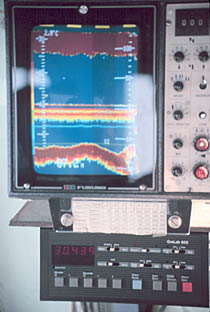Fisheries acoustics
While there are many manufacturers of commercially available "fish-finders," quantitative analysis requires that measurements be made with calibrated echo sounder equipment, having high signal-to-noise ratios.Passive acoustic methods can be an attractive alternative or supplement to traditional fisheries assessment techniques because they are noninvasive, can be conducted at low cost, and can cover a large study area at high spatial and temporal resolution.In 1929, the Japanese scientist Kimura reported disruptions in a continuous acoustic beam by sea bream swimming in an aquaculture pond.[3] In the early 1930s, two commercial fishermen, Ronald Balls, an Englishman, and Reinert Bokn, a Norwegian, began independently experimenting with echosounders as a means to locate fish.Sonar technologies developed rapidly during the Second World War, and military surplus equipment was adopted by commercial fishers and scientists soon after the end of hostilities.Large uncertainties persisted in the interpretation of acoustic surveys, however: calibration of instruments was irregular and imprecise, and the sound-scattering properties of fish and other organisms was poorly understood.This instrument operates on the same principles as a recreational or commercial fishfinder or echosounder, but is engineered for greater accuracy and precision, allowing quantitative biomass estimates to be made.In an echosounder, a transceiver generates a short pulse which is sent into the water by the transducer, an array of piezoelectric elements arranged to produce a focused beam of sound.In order to be used for quantitative work, the echosounder must be calibrated in the same configuration and environment in which it will be used; this is typically done by examining echoes from a metal sphere with known acoustic properties.TS can be derived theoretically for simple targets such as spheres and cylinders, but in practice, it is usually measured empirically or calculated with numerical models.
Fishfinder
sonar
Fishfinderresearchacoustical devicesaquaticaquatic animalszooplanktonhabitatBiomassabundanceecho sounderhardwarecalibratedsignal-to-noise ratiosRallier du Batysea breamEcho soundingechosounderpiezoelectricbeam patternMultibeam echosounderanadromousorange roughyTarget strengthDeep scattering layerBlackwellHydroacousticsActive acousticsBaffles (submarine)Bistatic sonarFessenden oscillatorGLORIA sidescan sonarPassive acousticsScientific echosounderSide-scan sonarSonobuoySurveillance Towed Array Sensor SystemSynthetic aperture sonarTowed array sonarUpward looking sonarOcean acousticsAcoustic networkAcoustic releaseAcoustic Doppler current profilerAcoustic seabed classificationAcoustical oceanographyHydrophoneLong baseline acoustic positioning systemOcean acoustic tomographyShort baseline acoustic positioning systemSofar bombSOFAR channelSound speed gradientSound velocity probeUltra-short baseline acoustic positioning systemUnderwater acousticsUnderwater acoustic communicationUnderwater acoustic positioning systemAcoustic ecologyAcoustic survey in fishingAcoustic tagAnimal echolocationBeached whaleMarine mammals and sonarWhale songAcoustic signatureBioacousticsBiophonyGeophysical MASINTHydrographic surveyNoise mapSoundscapeFisheryFisheries sciencewild fisheriesFisheriessciencePopulation dynamics of fisheriesShifting baselineFish stockFish mortalityCondition indexStock assessmentFish measurementStandard weight in fishFish counterData storage tagCatch per unit effortOtolith microchemical analysisCoded wire tagGIS and aquatic sciencePop-up satellite archival tagEcoSCOPEAge class structureTrophic levelTrophic cascadesHydrographic containmentMatch/mismatch hypothesisClimate change and fisheriesMarine biologyAquatic ecosystemsBioeconomicsEconMultEcopathFishBaseCensus of Marine LifeOSTM/Jason-2WildfisheriesOcean fisheriesDiversity of fishCoastal fishCoral reef fishDemersal fishForage fishPelagic fishCod fisheriesCrab fisheriesEel fisheriesKrill fisheriesLobster fisheriesShrimp fisheryEel ladderFish ladderFish screenMigrationSalmon runSardine runShoaling and schooling